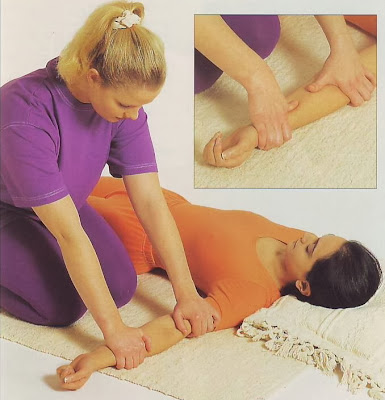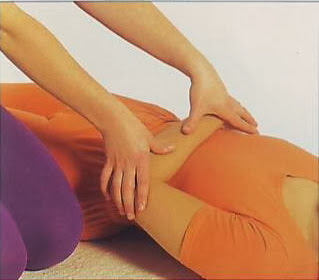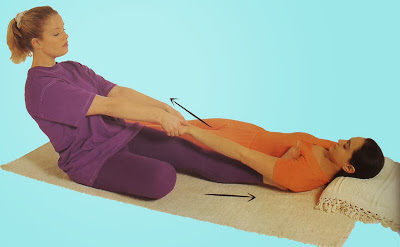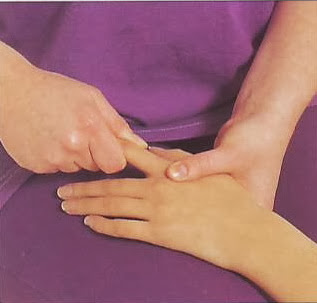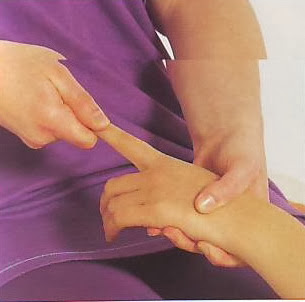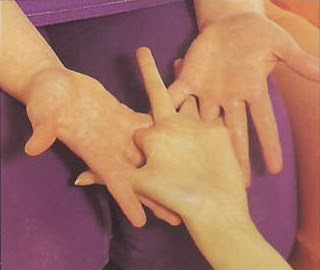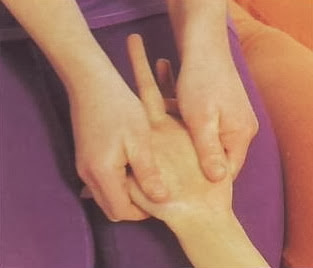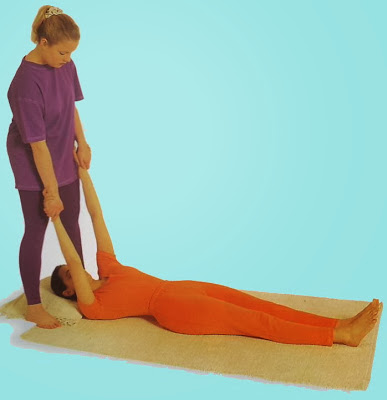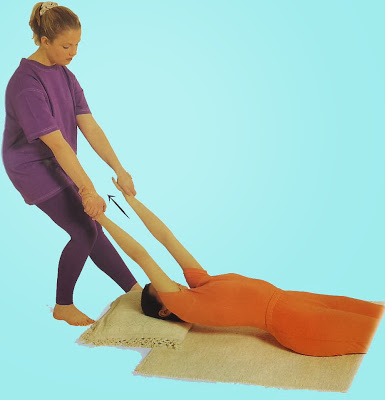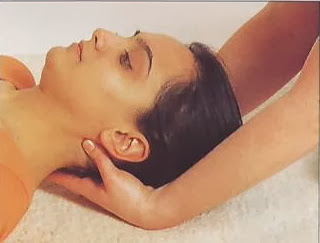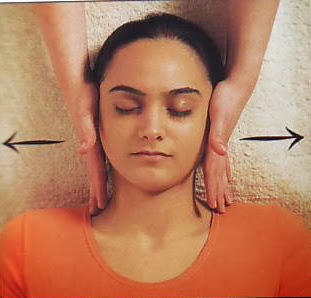Arms feed vital
energy into the body’s organ system and need thorough treatment to ensure
smooth energy flow. Shoulders store tension which causes neck pain and
headaches. Stretching the shoulders and neck relieves the tension, while
pressure on head energizes calms the mind.
Sen channels on the arms
 |
| The Inner Sen channels (left) are:
j
- Chinese Lung meridian, k
- Chinese Pericardium meridian, l
- Chinese Heart meridian. The Outer Sen channels (right) are: j
- Chinese Large Intestine meridian, k
- Chinese Sanjiao meridian, l
- Chinese Small Intestine meridian. |
A. Inner
Sen Channels
- Ÿ j - Starts behind the
thumb under the wrist and ends on deltoid muscle.
- Ÿ k - Starts on the
underside of the wrist in the midline and passes between radius and ulna bones
towards the armpit, where it ends.
- Ÿ l - Starts on the underside
of the wrist behind the little finger and ends in the armpit.
B.
Outer Sen Channels
- Ÿj - Starts on the
wrist crease behind the thumb and passes along the edge of the radius to the
outer elbow and up to the front of the shoulder.
- Ÿ k - Starts on the
middle of the wrist crease and passes between the radius and ulna and then over
the humerus to the deltoid muscle.
- Ÿ l - Starts on the
wrist crease behind the little finger and passes up to the back of the armpit.
1. PRESSING THE INNER ARM
Touch Method One: Palmar
Pressing Place your partner’s arm at right angles to her body with the palm
uppermost. Palm the inner Sen keeping your arms straight and bring your body
weight forward to create slow, deep pressure. Do this several times, both up
and down the Sen.
Touch Method Two: Thumb
Pressing Thumb the three Sen channels using the thumb walking technique. Maintain
a slow, steady rhythm throughout and cover the channels, working up and down at
least three times.
2. PRESSING THE OUTER ARM
Touch Method one:
Lift your partner’s arm and place it palm downwards across her chest. This exposes
the outer Sen channels which can now be palmed and thumbed using exactly the
same techniques as those used on the inner Sen channels.
Touch Method Two:
place your partner’s arm palm downwards on the mat. Change your kneeling
position to one behind her arm. Palm and thumb the outer Sen channels again.
- Relieves pain and stiffness in wrists, elbows and upper
arms. Balances Sen energies.

- 1. PRESSING THE
INNER ARM
Pressed: Biceps, wrist flexors
- 2. PRESSING THE OUTER ARM
Pressed: Deltoids, wrist extensors
3. FOOT TO ARMPIT STRETCH
Hold
your partner’s left hand and carefully place your foot in her armpit. Lean back
to create a strong pull against the pressure of your foot. Hold for ten
seconds.
- Stretches the shoulder muscles to relieve tension.
Always ensure that the arch
of your foot is placed across the actual armpit of your partner so that little
pressure is exerted on the lymph nodes.
4. STRETCHING THE ARM IN THE
TRIANGLE POSITION
Place the palm of your
partner’s left hand on the mat with her fingers directed towards her shoulder.
Palm the exposed area from elbow to armpit and back again.
Now place your left hand on the upper thigh and your right
hand on her elbow. Press down with both hands simultaneously to create a strong
stretch across the trunk between arm and thigh.
- Provides a rare treat for
the triceps muscles which are the recipient of the palming.
- Eases pain and improves mobility in the shoulders.

- 3. FOOT TO ARMPIT STRETCH
Pressed: Deltoid, rhomboideus,
trapezius, infraspinatus, supraspinatus
- 4. STRETCHING THE ARM IN THE TRIANGLE
POSITION
Stretched: Triceps, latissimus
dorsi, pectoralis major, wrist flexors
Pressed: Triceps
5. PRESSING THE TENDONS OF THE
UPPER HAND
Starting
from the wrist each time, thumb press along and across each of the five main
tendons on the back of your partner’s hand.
6. ROTATING, PRESSING & PULLING THE FINGERS
Touch Method one: holding
each finger in turn at the finger-tips, rotate the fingers several times in
both directions.
Touch Method Two:
Now squeeze up and down each finger using your index finger and thumb. Squeeze
first along the top and underside of each finger, followed by lateral
squeezing.
Touch Method Three:
Pull each finger in turn and use a strong, sliding action to create the necessary
extension. Do not be deterred by any cracking sounds that you hear when sharply
extending the finger joints as these are not harmful.
- Strengthens the fingers and
guards against osteo-arthritis.
7. KNEE TO HAND PRESSING
Press your partner’s left
palm against your knee upper shin to flex the wrist and fingers backwards.
Thumb press the heel of the palm and the wrist.
- Relieves carpal tunnel
syndrome, numbness and stiffness.
8. INTERLOCKED HAND PRESSING
With your partner’s palm
uppermost, interlock your fingers with those of your partner as follows:
- The fourth finger between fingers five and
four.
- Your fifth finger between fingers four and
three.
- Your right-hand fifth finger between fingers
three and two.
- Your third and fourth fingers between index
finger and thumb.
Slide
your fingers under the back of her hands leaving your thumbs free to press her
inside wrist and palm. Turn your hands outwards so the sides of your partner’s
palms are pulled downwards, leaving them arched and stretched. Press deeply
wherever you can.
- Gives a powerful backwards
stretch to the hand and digits, and relives numbness and stiffness.
9. ROTATING THE WRIST
Support your partner’s
forearm near the wrist and use an interlocked finger grip to rotate her wrist
strongly, first one way and then the other.
- Improves overall wrist
mobility and relives numbness of the wrists and hands.
10. PULLING THE ARMS
Touch Method One: Vertical
Arms Standing behind your partner’s shoulders, grasp both her hands and
then pull both arms up and down, lifting each shoulder alternately.
Touch Method Two: Backward
Pull Now step back from your partner and pull both her arms together
leaning with your body weight to create the pull.
- Reduces tension in the
shoulders and improves mobility of the shoulders.

Stretched: Hand flexors
- 8. INTERLOCKED HAND PRESSING
Stretched: Hand flexors
Stretched: Wrist & hand, flexors & extensors
Stretched: Trapezius, deltoids,
infraspinatus, rhomboideus, biceps, pectoralis major
11. PRESSING THE SHOULDERS
Kneel behind your partner’s
head. Press and push the top of her shoulders with both hands, initially
sustaining the press for several seconds. Then press and push alternately
without holding the presses. Finally, thumb press along the upper border of her
collar bone and over the upper regions of the pectoral muscles.
- Helps take tension from the
neck and shoulders, and improves shoulder mobility.
12. PRESSING THE NECK
Support the base of your
partner’s head with one hand, lifting it slightly forward so that your other
hand can press up and down the muscles on one side of her neck. Swap hands to
press the other side.
Turn your partner’s head to the right so that it rests on the
right temple. Press along the full length of the sternocleidomastoid muscle
with your left thumb.
13. STRETCHING THE NECK
Place both hands under your
partner’s lower neck and pull them towards you to create a mild traction on the
neck. Repeat several times. Keeping a slight traction, press with your fingers
into the soft tissue immediately behind the base of the skull. Hold for up to
one minute. Allow the weight of the head to generate the pressure.
14. PULLING THE TURNED HEAD
Place your right hand under
your partner’s chin and your left hand under the base of her skull using equal
pressure with both hands. Pull her head back very gently and carefully. Hold
the pull for at least ten seconds.
- Relaxes the neck muscles,
eases headaches and improves mobility of the neck.
15. MASSAGING THE FACE &
HEAD
Sitting behind your
partner’s head, place both thumbs on top her forehead on the hairline. Press
evenly on either side of her face following the directions of the arrows as
shown.
16. MASSAGING THE EARS
Cup and cover your
partner’s ears with the palm of your hands to create a suction. Hold for 30
seconds and then release.

- 11. PRESSING THE SHOULDERS
Pressed: Trapezius
Pressed: Sternocleidomastoid,
levator scapulae
- 14. PULLING THE TURNED HEAD
Stretched: Sternocleidomastoid,
trapezius, erector spinae, levator scapulae






